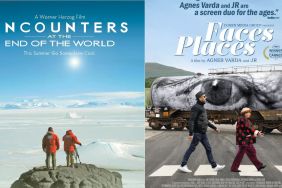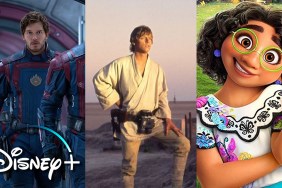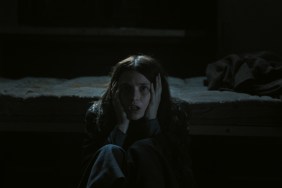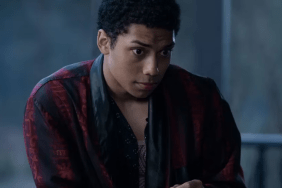Many filmmakers have tried to diversify by mixing it up between doing documentaries and narrative features–Seth Gordon, Davis Guggenheim and George Ratliff being three–but few directors have transitioned as fluidly from one to the other as Werner Herzog.
With over forty years of filmmaking under his belt, it’s sometimes hard to believe the director of insightful docs like Grizzly Man and Encounters at the End of the World could also be the man behind Rescue Dawn and Bad Lieutenant: Point of Call New Orleans.
Herzog’s films have taken him all over the globe from the jungles of South America to those of Thailand to the vast expanses of Antarctica, but his latest film Cave of Forgotten Dreams takes him into a more claustrophobic setting, that of the Chauvet Cave in Southern France. Discovered in the ’90s after being sealed for over 20,000 years, the walls of the cave was covered with ancient cave paintings by Neanderthal man and filled with the remains of animals dating back to the Ice Age. It was an amazing discovery that was completely unseen by anyone but the scientists, until Herzog decided to capture them using the latest 3D technology. By doing so, Herzog allows the viewer to experience what it must have been like for the first people to live within the cave system, as he thoughtfully examines what the existence of the cave paintings’ artists must have been like.
ComingSoon.net has spoken with Herr Herzog a number of times over the last few years, both for his dramatic features and docs, but we had a lot of questions about the logistics of this one, since it takes what he’s done in previous films to a different place.
ComingSoon.net: The Chauvet Cave was first discovered about 17 years ago, so when did you first hear about it and how long after that before you decided to take a camera crew down there?
Werner Herzog: Only shortly before I set out to make the film. I didn’t know about it, because nobody saw the cave with the exception of scientists and of course, the discoverers. It’s a monumental achievement to find these. If they hadn’t been around and searching for caves in this area, maybe for the next 20,000 years, we might not have found them, we might not have known about it.
CS: How did you find out about them?
Herzog: I was approached Erik Nelson, and he asked me. He was kind of cautious approaching me, “Would that possibly interest you, a Paleolithic cave?” and I said “Yes, yes, yes,” because he didn’t know that I had since early adolescence, I was absolutely intrigued by cave paintings, and it was my first intellectual awakening, so to speak, with fascination about something that was beyond school, peers or family. It was my first fascination out there. That was only I would say a year and a half ago.
CS: So it was right after “Encounters” or around the time you’d finished that.
Herzog: Yes.
CS: Cave paintings aren’t something you often see in art galleries so had you done any sort of cave exploring before.
Herzog: No, never been into any of these caves, and of course, some of the most famous ones like Lascaux, further north in France, Altamira in the Pyrénées, had to be shut down. Too many people entering and breathing changed the climate, and mold is growing now on the walls, and they can’t really control it. That was the danger also with Chauvet Cave, that’s why it’s so restrictive to let anyone in.
CS: You get the impression from watching the movie that it was easier to convince them to let you film inside the cave than it might have been? Was that the case? Was there a lot more petitions and discussions back and forth to make it happen?
Herzog: Yeah, it was a very complicated thing, because #1, the French Ministry of Culture has to agree or has to give you the permit, but there’s also the regional government, who also has to get a permit, and it’s the council of scientists, the custodians of the cave, have to give an okay as well, so it’s a fairly complex sort of thing. Of course, for the French, this is patrimony of their culture in a way, and sometimes, they can be territorial so (chuckles)…
CS: Were there French filmmakers who wanted to document the cave on film?
Herzog: Apparently, yes. I put a lot of effort into getting this permit and I was very lucky that the French Minister of Culture is a great fan of my films. I mean, truly truly deep love of my films, which made it easier to explain why is it that there is a Bavarian should do it instead of a French (filmmaker)? I proposed to work as an employee of the French Ministry of Culture for a fee of 1 Euro. In return, I would make the film and hand it to them for free for all the non-commercial rites. They can show it in 35,000 classrooms in France for free and in festivals and cultural events, it’s all theirs. It cost them 1 Euro. However, I explained that I would not pay taxes in France but in Germany on this Euro. (laughs)

CS: What’s the tax on 1 Euro?
Herzog: Well, German taxes are fairly high. (laughs) You pay something like 45% taxes. You have to earn more than 1 Euro all over the year, but no, the deal was that I work as an employee of the French Ministry of Culture and I earn my fee and charge them 1 Euro.
CS: Were the scientists familiar with your work, because you made connections into the scientific community with “Encounters.”
Herzog: Some of them, yes, not all, which was kind of pleasant and straight-forward, and I had a very easy rapport with them. You can tell from on-camera.
CS: Obviously, you’re well known as a filmmaker and explorer and adventurer in the way you make your films, but I get the impression that maybe at one point you wanted to be a scientist yourself. Is that the case?
Herzog: Well, my grandfather was an archaeologist and I always had an affinity to archaeology, but otherwise, as a scientist, maybe with the only exception of mathematics, and I mean not calculating things but pure mathematics.
CS: A lot of your movies have been in these expansive spaces, like jungles or Antarctica in “Encounters,” so how did you approach this one differently? The space is a lot tighter so is this a smaller crew than you normally work with?
Herzog: Well, I was only allowed three people with me… no, including me, it would be four.
CS: And that’s a smaller crew than you normally work with, smaller than “Encounters”?
Herzog: Well, that was only two. I did the sound and Peter Zeitlinger, the cinematographer, did the camera, but in this case, I got permission and I was invited to Antarctica, because (my crew) was so small. I learned the lesson. They refused… they did not invite James Cameron. Is his name “James”? James, the man who made “Titanic”?* Because he wanted to make a film in Antarctica and I think he proposed to bring 35 crew members with him. He had way too many people and I think that was an obstacle apparently, because maintaining a single person for a single day is very, very expensive.
(*Okay, we need to put in a footnote there, because most of you are probably thinking, “How can Werner Herzog not know the name ‘James Cameron’ when he’s made a 3D film?” As we learned the last time we spoke to Herzog, he didn’t seem to know who Jim Morrison and the Doors were, so there’s a chance that he really does live in his own world and doesn’t pay attention to things like other filmmakers. Or he could just be f*cking with us, again.)
CS: So this is a crew twice as big as “Encounters” so what were some of the safety concerns?
Herzog: I was only allowed to bring this amount of people. No real safety concerns with one exception. In one branch of the crave, there’s a high concentration of CO2 gas, so you’re always accompanied by two guards, and there are oxygen masks nearby, and they make sure you work less than an hour. After 45 minutes, you start to feel woozy, and of course, there’s a strict protocol of events. If somebody faints, who is the person to pick him up and if the person who is trying to evacuate faints as well, there’s a clear sequence of events, and prepared steps, which are completely script and they make a lot of sense.
CS: These are guards just for this area or guards who are always down there?
Herzog: They’re always in there throughout the year and they control the climate in there every fortnight or so, every week, they enter. In another part of the cave, there’s a fairly high concentration of radon gas, radioactive, which has a cumulative effect in your lungs, so you shouldn’t stay over too long periods of time either.
CS: Did that come from the nuclear reactors you show in the movie?
Herzog: No, it has nothing to do with it.
CS: I was going to say that radiation may be more harmful than having people walking around the cave. How long have those nuclear reactors been there?
Herzog: I don’t know, probably twenty years or so. I don’t really know, but the French actually have 75% of their electricity originates through nuclear power, I think the highest percentage of anywhere in the world.

CS: I was curious about the air in the caves, because as much as the film makes you feel as if you’re inside it, but as we watch it, we can’t really tell how claustrophobic or how good or bad the air is. How long were you able to stay down there before you had to go back out?
Herzog: We were allowed four hours per day and throughout the whole week, each day four hours, which is kind of restrictive but of course, it is not a caprice. It’s also not a caprice that you never ever step off the two-feet wide walkway, because right next to you, you’d have the footprints of cave bears. The footprints are fairly fresh but the cave bear has been extinct for more than 20,000 years. (laughs) It’s completely stunning, yes?
CS: It’s absolutely mindblowing. So you filmed for one week, four hours a day, that was the entire time you spent in the cave?
Herzog: That was my entire time, so you better be smart and you better take very competent people with you.
CS: You had worked with your DP Peter before, but how did you approach how you were going to use the 3D camera equipment. Did you do a lot of tests beforehand?
Herzog: No, no tests, but we did a lot of thinking beforehand, and of course, 3D is not just something uniform. You can establish 3D as if you’re sitting and looking at an aquarium at some distance from you, so you have the 3D body of the aquarium. The level of 3D is way outside of you. You can establish the level at the line of your eyes, you can even establish a line of 3D behind you, so you have to take some very basic decisions and you have to know why you’re doing this. Then of course, data management is fairly complex and how to deal with it in post-production, you better know about this beforehand.
CS: So you just spend a good amount of time beforehand figuring that out?
Herzog: No, not really, because once it was clear we were allowed to do it, we had a fairly narrow window of time and we gathered everyone quickly, and then we jumped right into it. We had a week beforehand, we tested equipment and we ran some tests, and we ran into trouble, and it was good we ran into trouble before we started shooting.
CS: One of the things about these 3D movies is that the studio movies shooting in 3D have big digital monitors where they can watch what they’re filming and you obviously couldn’t do that.
Herzog: Yes, because we were only able to bring with us what we could carry in our hands, and of course, we had to carry lights which absorbs quite a bit of battery power. You cannot run a cable into it. You have to have battery belts, and you have to be autonomous.
CS: You had some limitations on what kind of lights you could use, so how did you know that they could provide enough light for what you needed to film?
Herzog: We were limited in size and we had to use lights that emit no temperature. We knew pretty much what we wanted to capture and we knew how to capture it.
CS: It’s just really fascinating to me that you’re going into this environment that’s brand new… you weren’t able to scout in the cave before you were filming.
Herzog: In this case, I was allowed one hour in the cave without any camera or anything just to assess. I was very adamant to have a look into it and assess the situation, because otherwise, we would have made mistakes with the size of our equipment. “How narrow is the passage here? How low is the ceiling? Can we get a tripod through there or not?” So you better make sure before you start shooting. They understood it.
CS: You went back multiple days, so did you have to do adjustments as you went along each day?
Herzog: Not so much when we were in the cave for doing the main bulk of the shooting there. You always in a way have to make adjustments, but it’s a natural way to make a film.
CS: What about some of your concerns about the 3D? I know filmmakers who love working in the format but I’ve also talked to a few who have issues with the fact you can’t actually have solid white that you can’t do just yet.
Herzog: I have been and I’m still a mild skeptic of 3D. It’s not that it will take over everything like from black and white to color TV, it’s not going to happen like that. It’s more for the big fireworks, 4th of July, “Avatar” or so, but there is nothing beyond the fireworks. You cannot really develop an inner parallel separate story as an audience and emotionally step deep into it because the fireworks, yes, you look at it in astonishment and that’s about it. But you can’t really do a romantic comedy, for example. There’s not enough as an audience to live through a separate parallel story of hopes and anxieties. “Will the young lovers meet each other again or not?” and you project into the future of the story, and you overtake things and then you step back into the story. 3D I think absorbs too much with the spectacle, that you do not really develop other stories parallel and outside of what you see on the screen.

CS: I don’t know if you’ve heard but Roger Ebert, who is not a fan of 3D, has said that your movie is one of the only movies he’s liked in 3D.
Herzog: I thank him for that and I think he’s right. (chuckles)
CS: It is one of those movies where you could have gone into the Chauvet Cave and the film wouldn’t be the same experience as watching in 3D where you’re actually in those caves where you’d never be able to go normally. Were there any concerns about having theaters that could play your movie in 3D? Many of your movies have played in arthouses, though they’re gotten bigger now, and they’re not necessarily equipped for 3D.
Herzog: No, no, no, I never wanted to be in arthouse places. Some of them have shown my films, but the theaters are always the mother of all battles. I don’t want to be just specifically in arthouse places. I’ve always been mainstream, and all the early films, mainstream movies, though for some of them, it took decades to become sort of mainstream. Maybe I’m the secret mainstream.
CS: So do you think you’ll try to do more films in 3D?
Herzog: No, the film that I’m doing right now on Death Row inmates is not in 3D obviously, but the same thing, I was looking for a general title for a couple of films on Death Row inmates, and as a general title, it’s “Gazing into the Abyss” and all of a sudden, it would have been the right title for the cave film, looking deep into the recesses of time and the agents of the modern human soul, and it could be a title of many of my films, including “Grizzly Man” and “Bad Lieutenant.”
CS: Maybe if you did another box set of your films, that can be the title.
Herzog: (laughs) Alright, yes.
CS: I was curious about the Death Row film, because there have been many films about the inmates, so what’s your take on it and how is your film going to be different?
Herzog: It’s still in gestation. I just finished shooting and I started editing. It will be different from others.
CS: I’m not sure if I’ve ever asked you this before, but I thought at one point, someone wanted to make a dramatic film about Timothy Treadwell, the subject of “Grizzly Man.”
Herzog: Apparently, Leonardo DiCaprio bought the rights, but when he saw my film, I think he understood he would never be even half as good as Treadwell is as an actor. No actor can be better than Treadwell. Every actor in the world would pale against him himself.
CS: But you were never involved in that like you were with “Rescue Dawn”?
Herzog: I was not involved, but I do believe there was an idea, and I do believe it was Leonardo DiCaprio’s company who bought rights or an option.
CS: Do you have another narrative film you’re developing?
Herzog: Yes, I’m preparing something at the moment, and four or five feature films also lining up so… (laughs) They push me hard.
CS: Next year you have a pretty big birthday, turning 70…
Herzog: I don’t even know. Maybe you’re right, maybe you’re wrong. I’d have to check into my birth certificate. (chuckles)
CS: What are Werner Herzog’s hopes and dreams either leading up to that anniversary or following it? Is there anything that you want to get done before your 70th birthday?
Herzog: No, I try to keep things away from me, because projects are pushing me too hard. You see, I’ve never had a career. It’s always been like a home invasion of projects, uninvited.
CS: Uninvited but always welcomed in once they show up.
Herzog: (laughs) Once unmistakably there and raiding your kitchen, you gotta deal with them.
Herzog’s Cave of Forgotten Dreams opens on Friday, April 29 in New York (3D at the IFC Center and in 2D at the Lincoln Plaza Cinemas), Los Angeles and Chicago on Friday.









